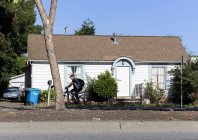
University Avenue
Laura Morton
Winner of the 2018 Canon Female Photojournalist Grant
This is a story of daily life in two communities living side by side in California’s Bay Area: Palo Alto and East Palo Alto. On one side Palo Alto has the massive fortunes created by Silicon Valley’s technology industry, while in East Palo Alto, mostly on the other side of Highway 101, the community has been squeezed out, away from these fortunes. One street, University Avenue, runs through the heart of both communities.
According to the U.S. Census Bureau, the average per capita income of Palo Alto residents is $82,576, but 6% are living below the poverty line. Millionaires and billionaires, including the executives of companies such as Apple and Facebook, call the city home. The statistics for East Palo Alto, right next door, are starkly different. East Palo Alto’s per capita income averages $22,068, with 13.7% living below the poverty line.
Preview



East Palo Alto’s status as a low-income community has its history in racial housing discrimination policies established after World War II when millions of African-American families left the Southern States for the West. Once in California, the newcomers were pushed into designated minority areas, and East Palo Alto became one of them. Racist policies such as redlining where banks refuse to give housing loans in minority community areas, kept property prices low. This had a trickle-down effect, with less money being available for schools and other public services. Today, East Palo Alto’s population is an estimated 63% Latino, and Palo Alto is an estimated 61% white.
While other communities in Silicon Valley saw an influx of wealth during the first Internet boom of the 1990s, East Palo Alto was relatively untouched by gentrification as crime scared away more affluent people. Today, the city is safe and has the last affordable land in the area. Longtime residents are now anxious, worrying that rising prices will transform their unique community and the cultural fabric that has survived and thrived for so many years.
Meanwhile, Palo Alto is dealing with its own issues caused by the economic success of the technology companies that, for the most part, emerged from it. The soaring cost of real estate priced out most middle-class buyers long ago, and now, with a median home value of $2,985,000, even high-earners are unable to afford the city. Longtime residents struggle as their city has turned from a sleepy suburban community into the epicenter of tech industry wealth.
The debate around the technology boom has tended to pit both communities against each other – the Haves and the Have-Nots, the tech executives and the working class – but I have strived to show what both communities have in common: slices of life that transcend wealth and poverty, privilege and disadvantage, and all the cultural disparities that stem from these differences.
This is a documentary record of residents of both communities who are, in their own way, working and going about their daily lives while living in the shadow of the technology giants.
Laura Morton



